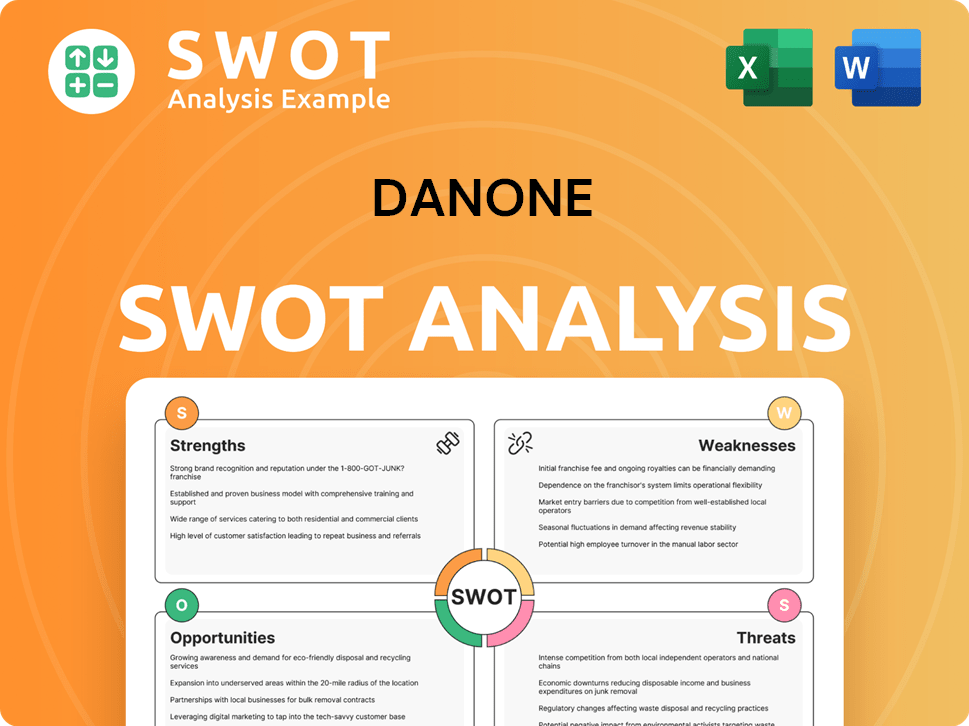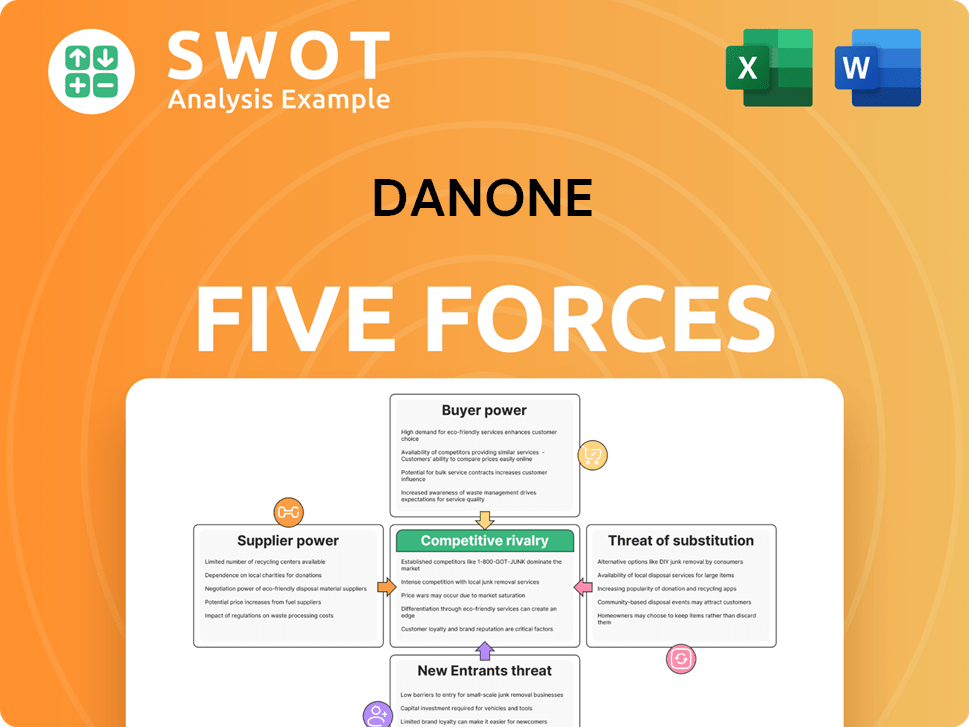Danone Bundle
How Does Danone Navigate the Ever-Changing FMCG Battleground?
Danone, a titan in the fast-moving consumer goods (FMCG) sector, constantly reshapes its strategy to stay ahead. The company's recent 'Renew' strategy highlights its commitment to profitable growth and a resilient supply chain. This sets the stage for a deep dive into the Danone SWOT Analysis and the fierce competition it faces.

From its origins in 1919, Danone has evolved into a global powerhouse, but the Danone competitive landscape remains incredibly dynamic. This Danone market analysis will explore the company's key rivals, its core strengths, and the industry trends influencing its future. Understanding Danone's competitors and its strategic positioning is crucial for anyone looking to understand the complexities of the food and beverage industry and the Danone industry.
Where Does Danone’ Stand in the Current Market?
Danone holds a prominent position in the global food and beverage sector. It is a major player in several key areas. In 2023, the company generated sales of approximately €27.6 billion, showcasing its significant scale within the industry. Its diverse product portfolio includes dairy and plant-based products, specialized nutrition, and bottled water.
The company's global presence is extensive, reaching consumers across Europe, North America, Latin America, Asia, and Africa. This wide geographic footprint allows Danone to cater to diverse consumer needs and preferences. The company's focus on health and sustainability, including its expansion into plant-based products, reflects evolving consumer trends.
Danone's market position is further strengthened by its strategic emphasis on health-oriented products and digital transformation initiatives. These efforts are designed to enhance consumer engagement and improve supply chain efficiency. The company consistently ranks among the top global players in its core segments. This is particularly evident in markets with high demand for health-focused products, such as dairy, plant-based alternatives, and specialized nutrition.
Danone holds the number one global position in plant-based products. It also secures the number two position in dairy and specialized nutrition worldwide. This leadership position reflects the company's strong brand recognition and consumer trust in these key segments. These positions highlight Danone's competitive advantages within the Danone competitive landscape.
In 2023, Danone reported sales of €27.6 billion. This financial performance underscores its robust market position. The company's ability to maintain strong sales figures indicates its resilience and competitiveness in the face of market challenges. This data is crucial for any Danone market analysis.
Danone has strategically shifted its focus towards health and sustainability. This includes a strong push into the plant-based market. The company is also embracing digital transformation to improve consumer engagement and supply chain efficiency. This approach allows Danone to adapt to changing consumer preferences and market dynamics, as detailed in the Marketing Strategy of Danone.
Danone serves diverse customer segments across Europe, North America, Latin America, Asia, and Africa. This broad geographic reach allows the company to capture a significant share of the global market. The company's ability to operate successfully in various regions demonstrates its adaptability and market understanding.
Danone faces intense competition in the food and beverage industry. Its success is influenced by consumer preferences, economic conditions, and regulatory changes. The company's ability to innovate and adapt to these factors is critical for maintaining its market position.
- Competitive Landscape: The Danone competitors include major players in the global food and beverage market.
- Market Share: While specific market share figures vary, Danone consistently ranks among the top players in its key segments.
- Innovation: Danone's focus on plant-based products and digital transformation demonstrates its commitment to innovation.
- Sustainability: The company's sustainability initiatives are increasingly important in the competitive landscape.
Danone SWOT Analysis
- Complete SWOT Breakdown
- Fully Customizable
- Editable in Excel & Word
- Professional Formatting
- Investor-Ready Format

Who Are the Main Competitors Challenging Danone?
The Danone competitive landscape is shaped by a diverse range of players, from global giants to nimble startups. Understanding these competitors is crucial for assessing Danone's market analysis and strategic positioning. The company faces intense competition across its various segments, including dairy, water, and specialized nutrition. This analysis provides insights into Danone's competitors and the dynamics of the Danone industry.
Danone's business strategy must account for the constant evolution of the food and beverage market. Factors such as consumer preferences, regulatory changes, and technological advancements all influence the competitive environment. This chapter examines the key players, their strategies, and the overall impact on Danone's performance.
To gain a deeper understanding of the consumer base, consider exploring the Target Market of Danone. This will provide valuable context for analyzing the competitive dynamics.
Danone's main rivals include large multinational corporations and smaller, specialized companies. These competitors challenge Danone's market share through various strategies, including product innovation, pricing, and distribution.
Nestlé is a major competitor, with a broad portfolio that overlaps significantly with Danone's. Nestlé's extensive distribution network and diverse brand offerings present a formidable challenge. In 2023, Nestlé's sales reached approximately CHF 95.2 billion.
PepsiCo is a significant player, particularly in the dairy and plant-based sectors. Through brands like Quaker, PepsiCo is expanding its presence in the health and wellness market. PepsiCo's net revenue in 2023 was over $86 billion.
Lactalis is a privately held French dairy company and a strong competitor in the dairy segment. Lactalis often competes through aggressive pricing and a strong presence in the European market. Lactalis's revenue in 2022 was approximately €28.2 billion.
Local dairy companies and emerging plant-based food startups also impact Danone's competitive landscape. These companies often leverage direct-to-consumer models and innovative ingredients to capture niche markets. Private label brands from major retailers also create pricing pressure.
Competition is particularly fierce in the plant-based milk alternatives and infant nutrition sectors. Mergers and acquisitions continue to reshape the competitive landscape. These factors require Danone to constantly adapt its strategies to maintain its position.
Danone's SWOT analysis should consider its competitive advantages and disadvantages in relation to its rivals. Key strategies include product innovation, marketing, and distribution. The company must also address the challenges posed by changing consumer preferences and market trends.
- Product Innovation: Developing new products and improving existing ones to meet consumer demand.
- Marketing: Building brand awareness and loyalty through effective marketing campaigns.
- Distribution: Optimizing distribution channels to ensure product availability.
- Sustainability: Focusing on sustainable practices to meet consumer and regulatory demands.
- Acquisitions and Mergers: Expanding its portfolio and market reach through strategic acquisitions.
Danone PESTLE Analysis
- Covers All 6 PESTLE Categories
- No Research Needed – Save Hours of Work
- Built by Experts, Trusted by Consultants
- Instant Download, Ready to Use
- 100% Editable, Fully Customizable

What Gives Danone a Competitive Edge Over Its Rivals?
The competitive landscape for Danone is shaped by its strong brand equity, extensive distribution network, and commitment to health and sustainability. The company's portfolio includes globally recognized brands like Activia, Evian, and Nutricia. These brands benefit from high consumer trust, allowing Danone to command premium pricing and maintain strong market positions. A thorough Danone market analysis reveals the importance of these factors in its ongoing success.
Danone's vast global distribution network ensures widespread product availability. This network spans traditional retail, e-commerce, and specialized channels for its nutrition products. The company's focus on research and development, particularly in probiotics and specialized formulations, provides a technological edge. Danone's commitment to sustainability, including B Corp certification for many brands and ambitious environmental targets, resonates with consumers.
These competitive advantages have evolved over time, with Danone integrating digital capabilities into its marketing and supply chain. However, these advantages face threats from imitation, particularly in the plant-based sector, and shifts in consumer preferences. Understanding these dynamics is crucial for assessing Danone's position in the Danone competitive landscape.
Danone's brand portfolio, including Activia, Evian, and Nutricia, enjoys strong consumer trust and loyalty. This brand strength enables premium pricing and robust market positions. In 2024, the company's focus on brand building and innovation contributed to a solid revenue performance.
Danone boasts a vast global distribution network, covering traditional retail, e-commerce, and specialized channels. This ensures widespread product availability and market penetration. The company's investment in supply chain efficiency continues to be a key strategic focus.
Danone's research and development efforts, especially in probiotics and specialized nutrition, provide a technological edge. The company leverages its expertise in fermentation and nutritional science. R&D spending in 2024 remained a significant portion of its overall budget.
Danone's commitment to sustainability, including B Corp certification and environmental targets, resonates with consumers. This focus on sustainability also extends to its supply chain, aiming for greater resilience and ethical sourcing. These initiatives are increasingly important in the Danone industry.
Danone's competitive advantages are multifaceted, including strong brand equity, extensive distribution, and a focus on innovation and sustainability. These strengths allow Danone to maintain a competitive edge in the global market. Understanding these advantages is crucial for a comprehensive Danone SWOT analysis.
- Strong Brand Portfolio: Globally recognized brands like Activia and Evian.
- Extensive Distribution: A vast network ensuring product availability.
- Innovation: R&D in probiotics and specialized nutrition.
- Sustainability: B Corp certification and environmental targets.
Danone Business Model Canvas
- Complete 9-Block Business Model Canvas
- Effortlessly Communicate Your Business Strategy
- Investor-Ready BMC Format
- 100% Editable and Customizable
- Clear and Structured Layout

What Industry Trends Are Reshaping Danone’s Competitive Landscape?
The food and beverage industry is currently experiencing significant shifts, driven by technological advancements, regulatory changes, and evolving consumer preferences. These trends present both challenges and opportunities for companies like Danone. A Growth Strategy of Danone reveals how the company navigates this dynamic environment.
The company's position, risks, and future outlook are closely tied to its ability to adapt to these changes. The competitive landscape of Danone is influenced by factors such as the demand for plant-based alternatives, regulatory impacts, and the emergence of new competitors. The company's strategic responses and investments in innovation and sustainability will shape its trajectory.
Technological advancements in food science and supply chain optimization are reshaping product development and distribution. Regulatory changes related to health, nutrition labeling, and environmental impact are influencing product formulations. Consumer preferences are shifting towards plant-based diets, sustainable products, and personalized nutrition.
Declining demand for traditional dairy in some markets necessitates investment in alternatives. Increased regulation around sugar content and environmental footprint could impact product formulations and production costs. Aggressive competitors are rapidly entering niche markets. Geopolitical instability and supply chain disruptions pose threats to operational efficiency.
Booming demand for plant-based products offers expansion potential. Emerging markets, with rising incomes, drive demand for branded food products. Innovations in personalized nutrition and sustainable packaging can unlock new revenue streams. Strategic partnerships can accelerate product development and market access.
Danone's 'Renew' strategy focuses on profitable growth and supply chain resilience. The company is aiming to optimize its portfolio and operations. The competitive position will likely evolve towards a more diversified and sustainably-focused portfolio. Danone leverages its brand strength and R&D capabilities.
Danone's market analysis indicates a need to balance traditional dairy with plant-based alternatives. The company must navigate regulatory pressures while innovating in product offerings. Successful adaptation to these trends will be critical for maintaining market share and driving future growth. The company's revenue in 2023 was approximately €27.6 billion.
- Continued investment in plant-based products is essential.
- Managing production costs in the face of increased regulations.
- Focusing on innovation in areas like personalized nutrition.
- Strategic partnerships to enhance market access and product development.
Danone Porter's Five Forces Analysis
- Covers All 5 Competitive Forces in Detail
- Structured for Consultants, Students, and Founders
- 100% Editable in Microsoft Word & Excel
- Instant Digital Download – Use Immediately
- Compatible with Mac & PC – Fully Unlocked

Related Blogs
- What are Mission Vision & Core Values of Danone Company?
- What is Growth Strategy and Future Prospects of Danone Company?
- How Does Danone Company Work?
- What is Sales and Marketing Strategy of Danone Company?
- What is Brief History of Danone Company?
- Who Owns Danone Company?
- What is Customer Demographics and Target Market of Danone Company?
Disclaimer
All information, articles, and product details provided on this website are for general informational and educational purposes only. We do not claim any ownership over, nor do we intend to infringe upon, any trademarks, copyrights, logos, brand names, or other intellectual property mentioned or depicted on this site. Such intellectual property remains the property of its respective owners, and any references here are made solely for identification or informational purposes, without implying any affiliation, endorsement, or partnership.
We make no representations or warranties, express or implied, regarding the accuracy, completeness, or suitability of any content or products presented. Nothing on this website should be construed as legal, tax, investment, financial, medical, or other professional advice. In addition, no part of this site—including articles or product references—constitutes a solicitation, recommendation, endorsement, advertisement, or offer to buy or sell any securities, franchises, or other financial instruments, particularly in jurisdictions where such activity would be unlawful.
All content is of a general nature and may not address the specific circumstances of any individual or entity. It is not a substitute for professional advice or services. Any actions you take based on the information provided here are strictly at your own risk. You accept full responsibility for any decisions or outcomes arising from your use of this website and agree to release us from any liability in connection with your use of, or reliance upon, the content or products found herein.